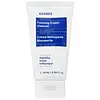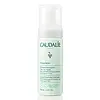What's inside
What's inside
 Key Ingredients
Key Ingredients

 Benefits
Benefits

 Concerns
Concerns

 Ingredients Side-by-side
Ingredients Side-by-side

Water
Skin ConditioningSodium Cocoyl Isethionate
CleansingCoco-Betaine
CleansingCetearyl Alcohol
EmollientDisodium Lauryl Sulfosuccinate
CleansingZea Mays Starch
AbsorbentGlycerin
HumectantCocamidopropyl Betaine
CleansingSodium Chloride
MaskingMagnesium Aluminum Silicate
AbsorbentSodium Methyl Cocoyl Taurate
CleansingGlyceryl Laurate
EmollientSclerotium Gum
Emulsion StabilisingAlpha-Glucan Oligosaccharide
CleansingAmaranthus Caudatus Seed Extract
Skin ConditioningChlorella Vulgaris Extract
Skin ConditioningCitric Acid
BufferingHydrogenated Castor Oil
EmollientHydrolyzed Rice Protein
Skin ConditioningLactic Acid
BufferingLactis Proteinum
Skin ConditioningLactobacillus
Skin ConditioningLactose
HumectantLaminaria Digitata Extract
Skin ProtectingLonicera Caprifolium Flower Extract
PerfumingLonicera Japonica Flower Extract
Skin ConditioningMaltodextrin
AbsorbentMaris Aqua
HumectantPentylene Glycol
Skin ConditioningPhenethyl Alcohol
MaskingPolymnia Sonchifolia Root Juice
Skin ConditioningSaccharide Isomerate
HumectantSodium Cocoyl Alaninate
Sodium Phytate
Titanium Dioxide
Cosmetic ColorantYogurt
Skin ProtectingYogurt Powder
Phenoxyethanol
PreservativeSodium Benzoate
MaskingParfum
MaskingWater, Sodium Cocoyl Isethionate, Coco-Betaine, Cetearyl Alcohol, Disodium Lauryl Sulfosuccinate, Zea Mays Starch, Glycerin, Cocamidopropyl Betaine, Sodium Chloride, Magnesium Aluminum Silicate, Sodium Methyl Cocoyl Taurate, Glyceryl Laurate, Sclerotium Gum, Alpha-Glucan Oligosaccharide, Amaranthus Caudatus Seed Extract, Chlorella Vulgaris Extract, Citric Acid, Hydrogenated Castor Oil, Hydrolyzed Rice Protein, Lactic Acid, Lactis Proteinum, Lactobacillus, Lactose, Laminaria Digitata Extract, Lonicera Caprifolium Flower Extract, Lonicera Japonica Flower Extract, Maltodextrin, Maris Aqua, Pentylene Glycol, Phenethyl Alcohol, Polymnia Sonchifolia Root Juice, Saccharide Isomerate, Sodium Cocoyl Alaninate, Sodium Phytate, Titanium Dioxide, Yogurt, Yogurt Powder, Phenoxyethanol, Sodium Benzoate, Parfum
Water
Skin ConditioningGlycerin
HumectantSodium Cocoyl Glutamate
CleansingCaprylyl/Capryl Glucoside
CleansingCocamidopropyl Betaine
CleansingCoco-Betaine
CleansingCaprylyl Glycol
EmollientCitric Acid
BufferingPotassium Sorbate
PreservativeSodium Cocoyl Isethionate
CleansingSodium Methyl Cocoyl Taurate
CleansingSodium Chloride
MaskingSodium Phytate
Butylene Glycol
HumectantChamomilla Recutita Flower Extract
MaskingLinalool
PerfumingSalvia Officinalis Leaf Extract
CleansingCitronellol
PerfumingVitis Vinifera Fruit Extract
Skin ConditioningParfum
MaskingWater, Glycerin, Sodium Cocoyl Glutamate, Caprylyl/Capryl Glucoside, Cocamidopropyl Betaine, Coco-Betaine, Caprylyl Glycol, Citric Acid, Potassium Sorbate, Sodium Cocoyl Isethionate, Sodium Methyl Cocoyl Taurate, Sodium Chloride, Sodium Phytate, Butylene Glycol, Chamomilla Recutita Flower Extract, Linalool, Salvia Officinalis Leaf Extract, Citronellol, Vitis Vinifera Fruit Extract, Parfum
 Reviews
Reviews

Ingredients Explained
These ingredients are found in both products.
Ingredients higher up in an ingredient list are typically present in a larger amount.
Citric Acid is an alpha hydroxy acid (AHA) naturally found in citrus fruits like oranges, lemons, and limes.
Like other AHAs, citric acid can exfoliate skin by breaking down the bonds that hold dead skin cells together. This helps reveal smoother and brighter skin underneath.
However, this exfoliating effect only happens at high concentrations (20%) which can be hard to find in cosmetic products.
Due to this, citric acid is usually included in small amounts as a pH adjuster. This helps keep products slightly more acidic and compatible with skin's natural pH.
In skincare formulas, citric acid can:
While it can provide some skin benefits, research shows lactic acid and glycolic acid are generally more effective and less irritating exfoliants.
Most citric acid used in skincare today is made by fermenting sugars (usually from molasses). This synthetic version is identical to the natural citrus form but easier to stabilize and use in formulations.
Read more about some other popular AHA's here:
Learn more about Citric AcidCocamidopropyl Betaine is a fatty acid created by mixing similar compounds in coconut oil and dimethylaminopropylamine, a compound with two amino groups.
This ingredient is a surfactant and cleanser. It helps gather the dirt, pollutants, and other impurities in your skin to be washed away. It also helps thicken a product and make the texture more creamy.
Being created from coconut oil means Cocamidopropyl Betaine is hydrating for the skin.
While Cocamidopropyl Betaine was believed to be an allergen, a study from 2012 disproved this. It found two compounds in unpure Cocamidopropyl Betaine to be the irritants: aminoamide and 3-dimethylaminopropylamine. High-grade and pure Cocamidopropyl Betaine did not induce allergic reactions during this study.
Learn more about Cocamidopropyl BetaineCoco-Betaine is the natural version of Cocamidopropyl Betaine. It is often derived from coconuts.
Coco-Betaine is a surfactant, meaning it helps remove dirt and oil from the skin.
Glycerin is already naturally found in your skin. It helps moisturize and protect your skin.
A study from 2016 found glycerin to be more effective as a humectant than AHAs and hyaluronic acid.
As a humectant, it helps the skin stay hydrated by pulling moisture to your skin. The low molecular weight of glycerin allows it to pull moisture into the deeper layers of your skin.
Hydrated skin improves your skin barrier; Your skin barrier helps protect against irritants and bacteria.
Glycerin has also been found to have antimicrobial and antiviral properties. Due to these properties, glycerin is often used in wound and burn treatments.
In cosmetics, glycerin is usually derived from plants such as soybean or palm. However, it can also be sourced from animals, such as tallow or animal fat.
This ingredient is organic, colorless, odorless, and non-toxic.
Glycerin is the name for this ingredient in American English. British English uses Glycerol/Glycerine.
Learn more about GlycerinParfum is a catch-all term for an ingredient or more that is used to give a scent to products.
Also called "fragrance", this ingredient can be a blend of hundreds of chemicals or plant oils. This means every product with "fragrance" or "parfum" in the ingredients list is a different mixture.
For instance, Habanolide is a proprietary trade name for a specific aroma chemical. When used as a fragrance ingredient in cosmetics, most aroma chemicals fall under the broad labeling category of “FRAGRANCE” or “PARFUM” according to EU and US regulations.
The term 'parfum' or 'fragrance' is not regulated in many countries. In many cases, it is up to the brand to define this term.
For instance, many brands choose to label themselves as "fragrance-free" because they are not using synthetic fragrances. However, their products may still contain ingredients such as essential oils that are considered a fragrance by INCI standards.
One example is Calendula flower extract. Calendula is an essential oil that still imparts a scent or 'fragrance'.
Depending on the blend, the ingredients in the mixture can cause allergies and sensitivities on the skin. Some ingredients that are known EU allergens include linalool and citronellol.
Parfum can also be used to mask or cover an unpleasant scent.
The bottom line is: not all fragrances/parfum/ingredients are created equally. If you are worried about fragrances, we recommend taking a closer look at an ingredient. And of course, we always recommend speaking with a professional.
Learn more about ParfumChances are, you eat sodium chloride every day. Sodium Chloride is also known as table salt.
This ingredient has many purposes in skincare: thickener, emulsifier, and exfoliator.
You'll most likely find this ingredient in cleansers where it is used to create a gel-like texture. As an emulsifier, it also prevents ingredients from separating.
There is much debate on whether this ingredient is comedogenic. The short answer - comedogenic ratings don't tell the whole story. Learn more about comegodenic ratings here.
The concensus about this ingredient causing acne seems to be divided. Research is needed to understand if this ingredient does cause acne.
Scrubs may use salt as the primary exfoliating ingredient.
Learn more about Sodium ChlorideSodium cocoyl isethionate is a natural ingredient from coconut oil. It is an ultra gentle cleanser that gives a nice foam without drying the skin or impacting the skin barrier.
The amount of foam created depends on the amount of sodium cocoyl isethionate used in the product.
This ingredient also helps improve the spreadability of a product.
Learn more about Sodium Cocoyl IsethionateThis gentle cleansing and foaming ingredient is known for leaving a smooth feeling in skin and hair. It is made using coconut oil.
According to the manufacturer, it is soluble in water and has resistance to hard water, acid, and alkali.
Due to its coconut base, it may not be Malassezia folliculitis safe.
Learn more about Sodium Methyl Cocoyl TaurateSodium Phytate is the synthetic salt form of phytic acid. Phytic acid is an antioxidant and can be found in plant seeds.
Sodium Phytate is a chelating agent. Chelating agents help prevent metals from binding to water. This helps stabilize the ingredients and the product.
Water. It's the most common cosmetic ingredient of all. You'll usually see it at the top of ingredient lists, meaning that it makes up the largest part of the product.
So why is it so popular? Water most often acts as a solvent - this means that it helps dissolve other ingredients into the formulation.
You'll also recognize water as that liquid we all need to stay alive. If you see this, drink a glass of water. Stay hydrated!
Learn more about Water